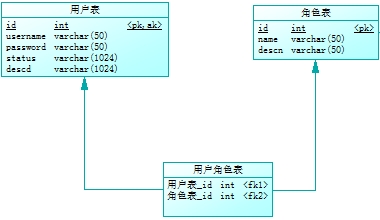Spring Security使用数据库中的用户进行身份认证
栏目:框架设计时间:2015-08-17 08:24:29
<dependency>
<groupId>mysql</groupId>
<artifactId>mysql-connector-java</artifactId>
<version>5.1.21</version>
</dependency>
<dependency>
<groupId>c3p0</groupId>
<artifactId>c3p0</artifactId>
<version>0.9.1.2</version>
</dependency>
/*
Navicat MySQL Data Transfer
Source Server : 10.0.0.12
Source Server Version : 50619
Source Host : 10.0.0.12:3305
Source Database : favsecurity
Target Server Type : MYSQL
Target Server Version : 50619
File Encoding : 65001
Date: 2015-01⑵3 10:28:39
*/
SET FOREIGN_KEY_CHECKS=0;
-- ----------------------------
-- Table structure for role
-- ----------------------------
DROP TABLE IF EXISTS `role`;
CREATE TABLE `role` (
`id` int(11) NOT NULL DEFAULT '0' COMMENT 'id',
`name` varchar(50) DEFAULT NULL COMMENT 'name',
`descn` varchar(50) DEFAULT NULL COMMENT 'descn',
PRIMARY KEY (`id`)
) ENGINE=InnoDB DEFAULT CHARSET=utf8 COMMENT='角色表';
-- ----------------------------
-- Records of role
-- ----------------------------
INSERT INTO `role` VALUES ('1', 'ROLE_ADMIN', '管理员角色');
INSERT INTO `role` VALUES ('2', 'ROLE_USER', '用户角色');
-- ----------------------------
-- Table structure for user
-- ----------------------------
DROP TABLE IF EXISTS `user`;
CREATE TABLE `user` (
`id` int(11) NOT NULL DEFAULT '0' COMMENT 'id',
`username` varchar(50) DEFAULT NULL COMMENT 'username',
`password` varchar(50) DEFAULT NULL COMMENT 'password',
`status` varchar(1024) DEFAULT NULL COMMENT 'status',
`descn` varchar(1024) DEFAULT NULL COMMENT 'descd',
PRIMARY KEY (`id`),
KEY `AK_Key_1` (`id`)
) ENGINE=InnoDB DEFAULT CHARSET=utf8 COMMENT='用户表';
-- ----------------------------
-- Records of user
-- ----------------------------
INSERT INTO `user` VALUES ('1', 'admin', 'admin', '1', '管理
员');
INSERT INTO `user` VALUES ('2', 'user', 'user', '1', '用户
');
INSERT INTO `user` VALUES ('3', 'favccxx', 'favboy', '1', '帅锅');
-- ----------------------------
-- Table structure for user_role
-- ----------------------------
DROP TABLE IF EXISTS `user_role`;
CREATE TABLE `user_role` (
`user_id` int(11) DEFAULT NULL COMMENT '用户表_id',
`role_id` int(11) DEFAULT NULL COMMENT '角色表_id',
KEY `FK_FK_USER_ROLE_ROLE` (`role_id`),
KEY `FK_FK_USER_ROLE_USER` (`user_id`),
CONSTRAINT `FK_FK_USER_ROLE_USER` FOREIGN KEY (`user_id`) REFERENCES `user` (`id`),
CONSTRAINT `FK_FK_USER_ROLE_ROLE` FOREIGN KEY (`role_id`) REFERENCES `role` (`id`)
) ENGINE=InnoDB DEFAULT CHARSET=utf8 COMMENT='用户角色表';
-- ----------------------------
-- Records of user_role
-- ----------------------------
INSERT INTO `user_role` VALUES ('1', '1');
INSERT INTO `user_role` VALUES ('1', '2');
INSERT INTO `user_role` VALUES ('2', '2');
INSERT INTO `user_role` VALUES ('3', '1');
INSERT INTO `user_role` VALUES ('3', '2');
<?xml version="1.0" encoding="UTF⑻"?>
<beans xmlns="http://www.springframework.org/schema/beans"
xmlns:xsi="http://www.w3.org/2001/XMLSchema-instance"
xmlns:context="http://www.springframework.org/schema/context"
xmlns:tx="http://www.springframework.org/schema/tx"
xmlns:aop="http://www.springframework.org/schema/aop"
xsi:schemaLocation="http://www.springframework.org/schema/beans http://www.springframework.org/schema/beans/spring-beans⑶.0.xsd
http://www.springframework.org/schema/context http://www.springframework.org/schema/context/spring-context⑶.0.xsd
http://www.springframework.org/schema/tx
http://www.springframework.org/schema/tx/spring-tx⑶.0.xsd
http://www.springframework.org/schema/aop http://www.springframework.org/schema/aop/spring-aop⑶.0.xsd
">
<context:property-placeholder location="classpath:database.properties"/>
<bean id="dataSource" class="com.mchange.v2.c3p0.ComboPooledDataSource" destroy-method="close">
<property name="driverClass">
<value>${dataSource.driverClassName}</value>
</property>
<property name="jdbcUrl">
<value>${dataSource.url}</value>
</property>
<property name="user">
<value>${dataSource.username}</value>
</property>
<property name="password">
<value>${dataSource.password}</value>
</property>
<!-- 最大连接数 -->
<property name="maxPoolSize">
<value>${dataSource.c3p0.max_size}</value>
</property>
<!-- 最小连接数 -->
<property name="minPoolSize">
<value>${dataSource.c3p0.min_size}</value>
</property>
<!-- 最大空闲时间,超时未被使用则连接被抛弃,单位毫秒 -->
<property name="maxIdleTime">
<value>${dataSource.c3p0.max_idle_time}</value>
</property>
<!-- 取得连接的超时时间,如果超过这个时间,会抛出异常,单位毫秒 -->
<!--
<property name="checkoutTimeout">
<value>${dataSource.c3p0.checkout_timeout}</value>
</property>
-->
<!-- 最大的PreparedStatement的数量 -->
<property name="maxStatements">
<value>${dataSource.c3p0.max_statements}</value>
</property>
<!-- 每隔120秒检查连接池里的空闲连接 ,单位是秒 -->
<property name="idleConnectionTestPeriod">
<value>${dataSource.c3p0.idle_test_period}</value>
</property>
<!-- 当连接池里面的连接用完的时候,C3P01下获得的新的连接数 -->
<property name="acquireIncrement">
<value>${dataSource.c3p0.acquire_increment}</value>
</property>
</bean>
</beans>
<![CDATA[
dataSource.driverClassName=com.mysql.jdbc.Driver
dataSource.username=favccxx
dataSource.password=favboy
dataSource.url=jdbc:mysql://10.0.0.12:3305/favsecurity?useUnicode=true&characterEncoding=utf⑻
# For c3p0 connect pool
dataSource.c3p0.max_size=200
dataSource.c3p0.min_size=10
dataSource.c3p0.max_idle_time=300
#dataSource.c3p0.checkout_timeout=30000
dataSource.c3p0.max_statements=0
dataSource.c3p0.idle_test_period=120
dataSource.c3p0.acquire_increment=5
]]>
------分隔线----------------------------
------分隔线----------------------------


